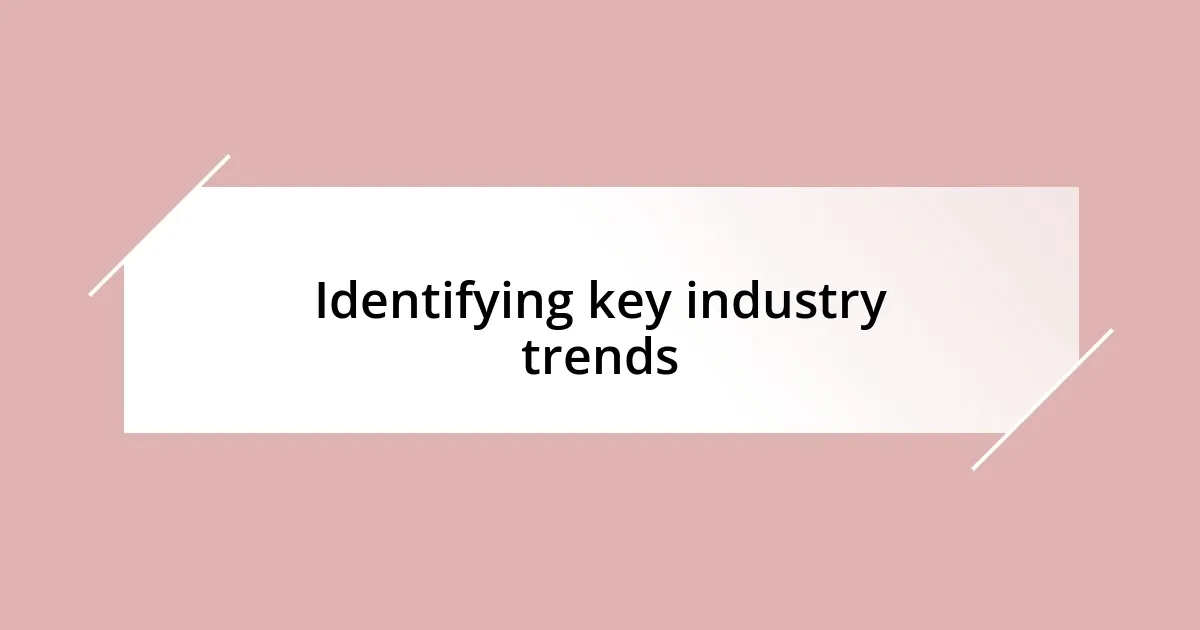Key takeaways:
- The mining industry is increasingly prioritizing sustainability and reducing its carbon footprint amidst rising demands for minerals like lithium and cobalt.
- Key trends in mining include digital transformation, decarbonization, and stronger focus on supply chain resilience and investor transparency.
- Technology such as AI, remote-operated vehicles, and blockchain is enhancing safety, productivity, and transparency, reshaping operational standards in mining.
- Collaboration with industry partners and community engagement is vital for evolving practices and fostering trust, ultimately leading to more responsible mining operations.

Understanding current mining demands
One thing that really stands out to me about current mining demands is the growing emphasis on sustainable practices. I remember visiting a mining site a few years ago where they showcased how they’re reducing their carbon footprint. It was inspiring to see companies shifting towards less invasive methods, but it also made me wonder—how far can we push sustainability in a traditionally resource-heavy industry?
As technology evolves, the demand for specific minerals, like lithium and cobalt, has skyrocketed due to the rise of electric vehicles and renewable energy solutions. Just thinking about the minerals that power our devices brings me a sense of urgency; these materials are not just valuable, they’re essential for our transition to a greener future. Are we equipped to meet this demand without compromising the earth?
Lastly, the global landscape is shifting rapidly with geopolitical factors influencing mining operations around the world. I recall a conversation with a mining executive who discussed how trade policies directly impact resources’ availability and pricing. It made me consider—what does this mean for the future of mining? Understanding these dynamics is crucial for anyone involved in or affected by the industry.

Identifying key industry trends
When I set out to identify key industry trends in mining, I look for patterns that signal where the market is heading. For instance, I can vividly recall a conference I attended where the discussions centered on smart mining technology. It hit me how much real-time data is revolutionizing decision-making in the sector. The industry’s trajectory is undeniably being shaped by innovations that enhance efficiency and sustainability.
Here are some key trends I’ve noticed:
- Digital Transformation: Many companies are adopting automation and AI to optimize operations.
- Decarbonization Focus: There’s a robust movement toward implementing environmentally friendly technologies.
- Resilience in Supply Chains: Firms are actively working to safeguard against disruptions by diversifying their sources.
- Investor Activism: Shareholders are increasingly demanding transparency regarding environmental and social governance (ESG) practices.
- Demand for Rare Earth Elements: The increased need for advanced technologies is pushing the mining of these critical minerals to the forefront.
Reflecting on these trends makes me excited and hopeful, knowing that the industry is not just responding to challenges but is also proactively shaping a more sustainable future.

Leveraging technology in mining
Leveraging technology in mining is a game changer. I remember during a tour of a state-of-the-art mining facility, I saw remote-operated vehicles and drones in action. It felt like something out of a sci-fi movie, but the reality is that these innovations drastically enhance safety. When I think about the exposure miners previously faced, leveraging technology helps mitigate those risks while increasing productivity.
Artificial intelligence is another fascinating area that I’ve seen gaining traction. I once spoke with a data scientist who specialized in predictive analytics for mineral exploration. They explained how algorithms could analyze geological data to identify the most promising areas for mining. I was genuinely intrigued; this technology not only helps in increasing yields but also optimizes resource use, which is crucial as we navigate more stringent environmental regulations.
Taking it a step further, the advent of blockchain technology is also reshaping transparency and traceability in the mining sector. I recall a meeting with a sustainable mining advocate who highlighted how blockchain could track minerals from extraction to market. This could significantly enhance accountability, reassure consumers, and ensure that companies are adhering to ethical practices. It’s these kinds of advancements that not only streamline operations but also align with the industry’s evolving demands.
| Technology | Impact |
|---|---|
| Remote-operated Vehicles | Enhances safety & productivity |
| Artificial Intelligence | Improves mineral exploration & resource optimization |
| Blockchain | Enhances transparency & traceability |

Implementing sustainable practices
Implementing sustainable practices in mining is not just a trend; it’s a necessity I’ve personally embraced. I recall a workshop I attended where the speaker emphasized the importance of reducing water waste through innovative recycling techniques. It struck me how much we, as an industry, can pivot our methods to conserve this precious resource, especially in areas facing water scarcity. Why wait for regulations to drive change when we can take initiative ourselves?
In my experience, integrating renewable energy sources, like solar and wind, into mining operations is a powerful step toward sustainability. I once visited a mining site that had begun utilizing solar panels; seeing them harnessing energy from the sun while minimizing fossil fuel reliance was exhilarating. It made me ponder: if miners can embrace these technologies, what might stop us from achieving even greater sustainability goals?
Moreover, I believe community engagement plays a crucial role in implementing sustainable practices. I once had a heartfelt conversation with a local resident near a mining site who expressed concerns about environmental impacts on their land. Listening to their stories made me realize that effective communication and collaboration with communities can lead to more responsible mining. Isn’t it fascinating how these relationships can foster trust and enable us to tailor our efforts to meet both industry goals and community needs?

Enhancing workforce skills and training
To keep pace with the rapid changes in the mining industry, enhancing workforce skills and training is paramount. I remember a time when I accompanied my team to a training session focused on new machinery operation. The sheer excitement in the room was palpable; everyone was eager to learn and apply this new knowledge. It’s clear that ensuring our workforce is well-equipped with the latest skills not only boosts confidence but also drives operational efficiency.
I often reflect on how essential it is to embrace continuous learning. In a previous role, we implemented a mentorship program that paired seasoned miners with newer employees. The exchange of knowledge was invaluable, and I witnessed firsthand how this initiative fostered a supportive environment. It reminded me that cultivating a culture of ongoing development is key to bridging the gap between experience and innovation in our workforce.
Moreover, utilizing virtual and augmented reality for training is something I believe could revolutionize our approach. I once participated in a VR simulation that detailed emergency procedures. It was immersive and eye-opening! Engaging employees through such cutting-edge methods makes training more relatable and practical. When I think about the potential here, I can’t help but wonder: how many lives could we save by ensuring our teams are adequately prepared for real-world challenges?

Collaborating with industry partners
Collaborating with industry partners is something I view as essential for navigating the evolving demands in mining. I clearly remember a collaboration my team initiated with a technology firm, where we explored integrating advanced analytics into our processes. This partnership opened my eyes to how leveraging each other’s strengths can lead to groundbreaking improvements that neither party could achieve alone. Have you ever thought about what synergies might exist in your own partnerships?
One aspect I find fascinating is the mutual learning that happens during these collaborations. While working with an environmental consultant, I had a revelation about the importance of incorporating ecological considerations into project planning. It was eye-opening to see how their insights transformed our approach, not just in compliance but in genuinely enhancing our operations’ sustainability. Isn’t it remarkable how quickly a change in perspective can drive significant advancements?
Finally, I strongly believe that these collaborations should extend beyond just the technical aspects. I engaged in a roundtable discussion with multiple stakeholders focused on community impact, and I felt the energy in the room shift as we shared our experiences. It became clear that aligning our goals with those of local communities creates a more holistic approach to mining operations. How often do we take the time to truly listen to one another and build relationships that empower both the industry and the communities we serve?

Measuring impact and outcomes
Measuring impact and outcomes is where I believe the true value of our efforts lies. After implementing new mining techniques, we decided to analyze their effectiveness through metrics like productivity and safety incidents. I recall the surprise I felt when the data revealed a more significant reduction in accidents than anticipated; it underscored just how impactful our adjustments could be. Isn’t it fascinating how numbers can tell such a compelling story?
In a recent project, we employed comprehensive feedback loops to gauge employee engagement and satisfaction over time. I vividly remember one feedback session when a younger miner expressed how the changes made her feel safer and more valued. Hearing such sentiments reinforced my belief that our measuring processes must extend beyond just numbers; they should capture the human experience too. Don’t you think it’s crucial to listen to those on the ground?
Moreover, exploring the long-term sustainability of our initiatives has become a priority for me. In one case, I analyzed the environmental impact of a new extraction method over several years. The ongoing assessment not only highlighted areas for improvement but also instilled a sense of responsibility within the team. It really made me wonder: How often do we pause to check if our progress aligns with our values and goals?














